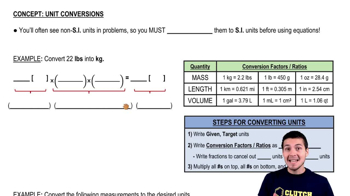Here are the essential concepts you must grasp in order to answer the question correctly.
Thermal Energy
Thermal energy refers to the total kinetic energy of the particles in a substance due to their motion. In gases, this energy is directly related to the temperature, as higher thermal energy indicates faster-moving particles. The relationship between thermal energy and temperature is crucial for understanding how energy is distributed among particles in a gas.
Recommended video:
Ideal Gas Law
The Ideal Gas Law is a fundamental equation in thermodynamics that relates pressure, volume, temperature, and the number of moles of a gas. It is expressed as PV = nRT, where P is pressure, V is volume, n is the number of moles, R is the ideal gas constant, and T is temperature in Kelvin. This law helps in calculating the temperature of a gas when its thermal energy and amount are known.
Recommended video:
Ideal Gases and the Ideal Gas Law
Temperature Conversion
Temperature conversion is the process of changing temperature values from one scale to another, such as from Kelvin to Celsius. The conversion from Kelvin to Celsius is done using the formula °C = K - 273.15. Understanding this conversion is essential for accurately interpreting temperature readings in different contexts, especially in thermodynamic calculations.
Recommended video:




